目录
Playbook的组成部分
实例模版
切换用户
指定声明用户
声明和引用变量,以及外部传参变量
playbook的条件判断
编辑
习题
编辑
ansible-playbook的循环
item的循环
编辑
list循环
编辑
together的循环(列表对应的列,数据结合的方式循环)
编辑
nested循环
Templates模块
实验httpd
yml文件
实验nginx
任务标签的种类
任务标签
自定义标签
实验
Role模块
roles结构
实验
Playbook的组成部分
1、task 任务:包含要在目标主机上执行的操作,使用模块定义这些操作,每个任务都是一个模块的调用
2、variables 变量:存储和传递数据,变量可以自定义,可以在Playbook当中定义为全局变量,也可以外部传参
3、Templates 模版:用于生成配置文件,模版是包含占位符的文件,占位符由Ansible在执行时转化为变量值
4、handler 处理器:当需要有变更的时候,可以执行触发器
5、Roles 角色:是一种组织和封装Playbook的,允许把相关的任务,变量,模版和处理器组成一个可复用的单元
实例模版
vim test.yml
#this is our first playbook
- name: first play
#一个name就是一个任务名,名字可以不写gather_facts: false
#是否收集目标主机的系统信息,false就是不收集hosts: 20.0.0.11
#执行的目标主机remote_user: root
#在目标主机执行的用户tasks:- name: ping testping:- name: close selinuxcommand: '/sbin/setenforce 0'ignore_errors: True- name: close firewalldservice: name=firewalld state=stopped- name: install httpdyum: name=httpd- name: start httpdservice: enabled=true name=httpd state=started- name: editon index.htmlshell: echo "this is httpd" > /var/www/html/index.htmlnotify: restart httpdhandlers:- name: restart httpdservice: name=httpd state=restarted#检查yaml文件的语法是否错误
ansible-playbook 文件名 --syntax-check
#查看yml文件里面有几个任务
ansible-playbook 文件名 --list-task
#检查生效的目标主机
ansible-playbook 文件名 --list-hosts
#运行命令
ansible-playbook 文件名ansible-playbook 文件名 --start-at-task='install httpd'
-k(–ask-pass):用来交互输入ssh密码
-K(-ask-become-pass):用来交互输入sudo密码
-u:指定用户切换用户
关闭免密
vim /etc/ansible/ansible.cfg
71行
注释掉编写脚本
hosts: 20.0.0.11
#执行的目标主机
remote_user: xiaobu
become: yes
become_user: root指定声明用户
在脚本里不声明用户,运行时,声明用户
ansible-playbook 脚本 -u root -k声明和引用变量,以及外部传参变量
vim test1.yml
#this is second playbook!
#声明和引用变量,以及外部传参变量
- hosts: 20.0.0.11remote_user: rootvars:groupname: xiaobu1username: xiaokai
#字典方式: key-value
#vars:
#-
#-
#列表listtasks:- name: create groupgroup:name: "{{ groupname }}"system: yesgid: 111- name: create useruser:name: "{{ username }}"uid: 1011group: "{{groupname}}"shell: /sbin/nologin- name: copy filecopy:content: "{{ hostvars[inventory_hostname]['ansible_default_ipv4']['address'] }}"
#获取目标主机的IP地址,然后复制到目标文件
# 包含所有主机变量的字典
#inventory_hostname 目标主机名
#ansible_default_ipv4 获取目标主机名
#['ansible_default_ipv4']['address'] 索引dest: /opt/test.txt外部传参变量
vim test1.yml
#this is second playbook!
#声明和引用变量,以及外部传参变量
- hosts: 20.0.0.12remote_user: roottasks:- name: create groupgroup:name: "{{ groupname }}"system: yesgid: 111- name: create useruser:name: "{{ username }}"uid: 1011group: "{{groupname}}"shell: /sbin/nologin- name: copy filecopy:content: "{{ hostvars[inventory_hostname]['ansible_default_ipv4']['address'] }}"dest: /opt/test.txt外部传参
ansible-playbook test1.yml -e 'username=xiaobu2 groupname=xiaokai1'
playbook的条件判断
when 是一个比较常见的应用长江,实现满足条件即执行,不满足条件即跳过的任务,when是满足条件即执行,不满足不执行。
vim test2.yml
#this is when test
- hosts: all
#可以用主机的IP地址,也可以是用组名,也可以用allremote_user: roottasks:- name: test whendebug:msg: '位置判断'
#打印相当于echo msg: 输出的内容,debug: 用于脚本的调试,在正式脚本中可以去除when: ansible_default_ipv4.address == '20.0.0.11'
#when: ansible_default_ipv4.address == '20.0.0.11'或者 when: inventory_hostname != '20.0.0.11'
#ansible_default_ipv4.address != '20.0.0.11' 取反习题
现在hosts all
条件1 IP 11:安装nginx
条件2 IP 12:安装httpd
#this is when test
- hosts: allremote_user: roottasks:- name: nginxyum: name=nginxwhen: ansible_default_ipv4.address == '20.0.0.11'- name: nginx infodebug:msg: '安装nginx'when: ansible_default_ipv4.address == '20.0.0.11'- name: httpdyum: name=httpdwhen: ansible_default_ipv4.address == '20.0.0.12'- name: httpd infodebug:msg: '安装httpd'when: ansible_default_ipv4.address == '20.0.0.12'ansible-playbook的循环
ansible有多种循环格式,with_items 循环遍历
item的循环
声明变量item,playbook的内置变量,with_items,会把item的值,遍历列表当中的a,b,c,d
vim test4.yml
- hosts: 20.0.0.12remote_user: rootgather_facts: falsetasks:- debug:msg: "{{ item }}"with_items: - [a,b,c,d]- [1,2,3,4]
#声明变量item,playbook的内置变量,with_items,会把item的值,遍历列表当中的a,b,c,d
#虽然我声明的列表是两个,但是with_items还是把两个列表当成整体进行遍历list循环
列别分组循环
#分组打印with_list: - [a,b,c,d]- [1,2,3,4]- hosts: 20.0.0.12remote_user: rootgather_facts: falsetasks:- name: create filefile:path: "{{ item }}"state: touchwith_items:- /opt/a- /opt/b- /opt/c- /opt/d- /opt/1- /opt/2- /opt/3- /opt/4together的循环(列表对应的列,数据结合的方式循环)
组循环,列表当中的值一一对应打印出来
- hosts: 20.0.0.12remote_user: rootgather_facts: falsetasks:- debug:msg: "{{ item }}"with_together:- [a,b,c,d]- [1,2,3,4]- [A,B,C]
nested循环
相当于双循环,第一层定义循环的次数,第二层表示第一层的每一个元素会循环几次
列表里面的元素定义了循环的次数,第二层列表,相当于内循环
- hosts: 20.0.0.12remote_user: rootgather_facts: falsetasks:- debug:msg: "{{ item }}"with_nested:- [a,b,c,d]- [1,2,3,4]
Templates模块
Jinja模版架构,通过模版可以实现向模版文件传参(Python转义),把占位符参数传到配置文件中去
生成一个目标文本文件,传递变量到需要配置文件当中
实验httpd
yum -y install httpd
cd /etc/httpd/conf
cp httpd.conf /opt/httpd.conf.j2
httpd.conf.j2 在文件当中配置的是占位符(声明的变量)
/etc/ansible/hosts 配置了主机的占位符名称和j2文件中的占位符一致(定义参数:占位符的参数的参数声明好)
playbook当中,Template模块来吧参数传给目标的主机的配置文件
vim /opt/httpd.conf.j2
42行
Listen {{http_port}}
95行
ServerName {{server_name}}
119行
DocumentRoot "{{root_dir}}"修改ansible配置文件
20.0.0.11 http_port=20.0.0.11:80 server_name=www.xiaobu.com:80 root_dir=/etc/httpd/htdocs20.0.0.12 http_port=20.0.0.12:80 server_name=www.xiaobu.com:80 root_dir=/etc/httpd/htdocs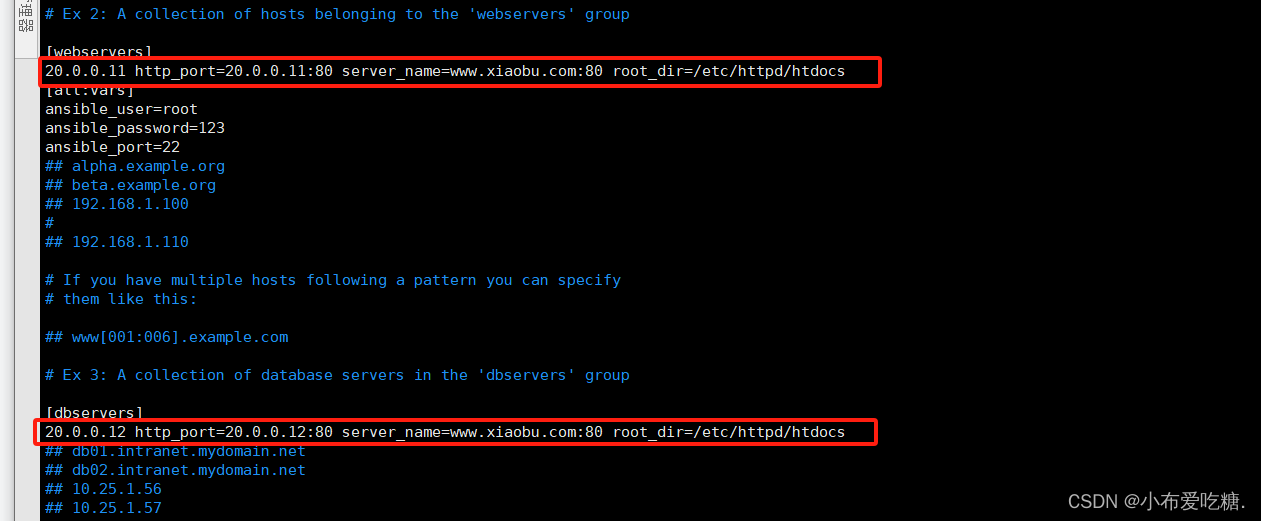
yml文件
- hosts: allremote_user: rootvars:- package: httpd- service: httpdtasks:- name: install httpdyum: name={{package}}- name: install config filetemplate: src=/opt/httpd.conf.j2 dest=/etc/httpd/conf/httpd.confnotify:- restart httpd- name: create root_dirfile:path: /etc/httpd/htdocsstate: directory- name: start httpdservice: name={{service}} enabled=true state=startedhandlers:- name: restart httpdservice: name={{service}} state=restarted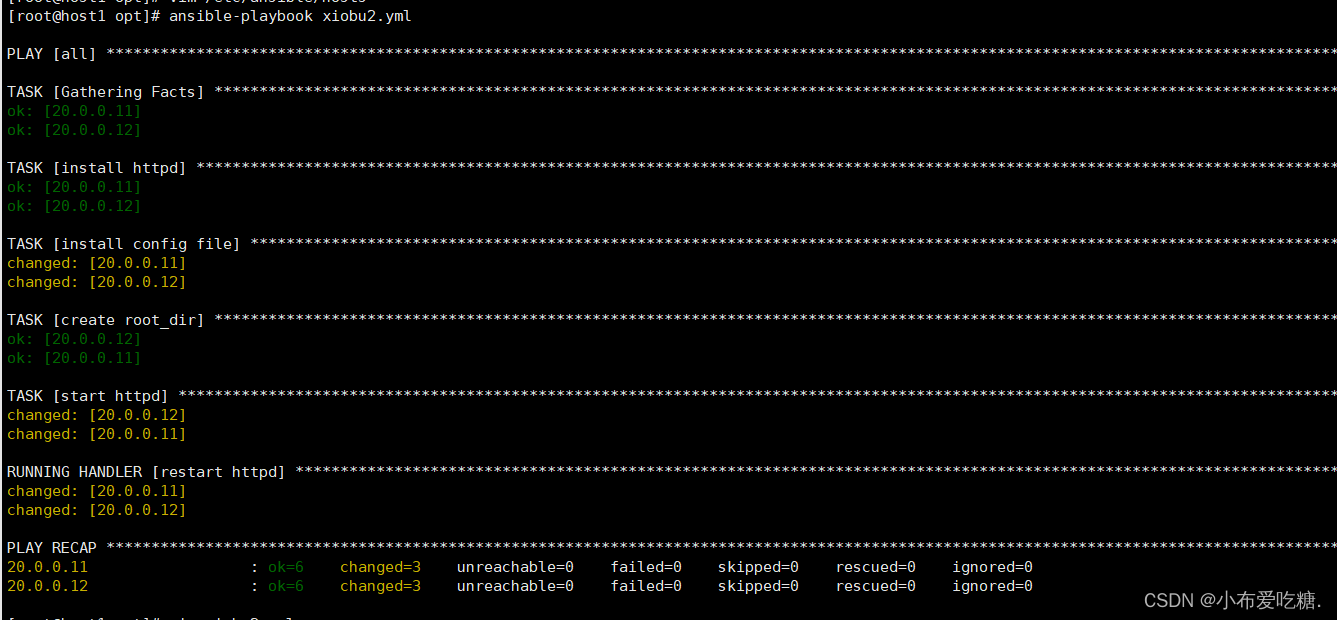
实验nginx
cp /etc/nginx/nginx.conf /opt/nginx.conf.j2修改nginx.的配置文件server {listen {{nginx_port}};server_name {{servername}};root {{root_dir}};
}修改ansible的配置文件
20.0.0.11 nginx_port=8080 servername=www.xiaobu.com root_dir=/etc/nginx/html20.0.0.12 nginx_port=8080 servername=www.xiaobu.com root_dir=/etc/nginx/htmlyml文件- hosts: allremote_user: rootvars:- package: nginx- service: nginxtasks:- name: install nginxyum: name={{package}}- name: install config filetemplate: src=/opt/nginx.conf.j2 dest=/etc/nginx/nginx.confnotify:- restart nginx- name: create root_dirfile:path: /etc/nginx/htmlstate: directory- name: start nginxservice: name={{service}} enabled=true state=startedhandlers:- name: restart nginxservice: name={{service}} state=restarted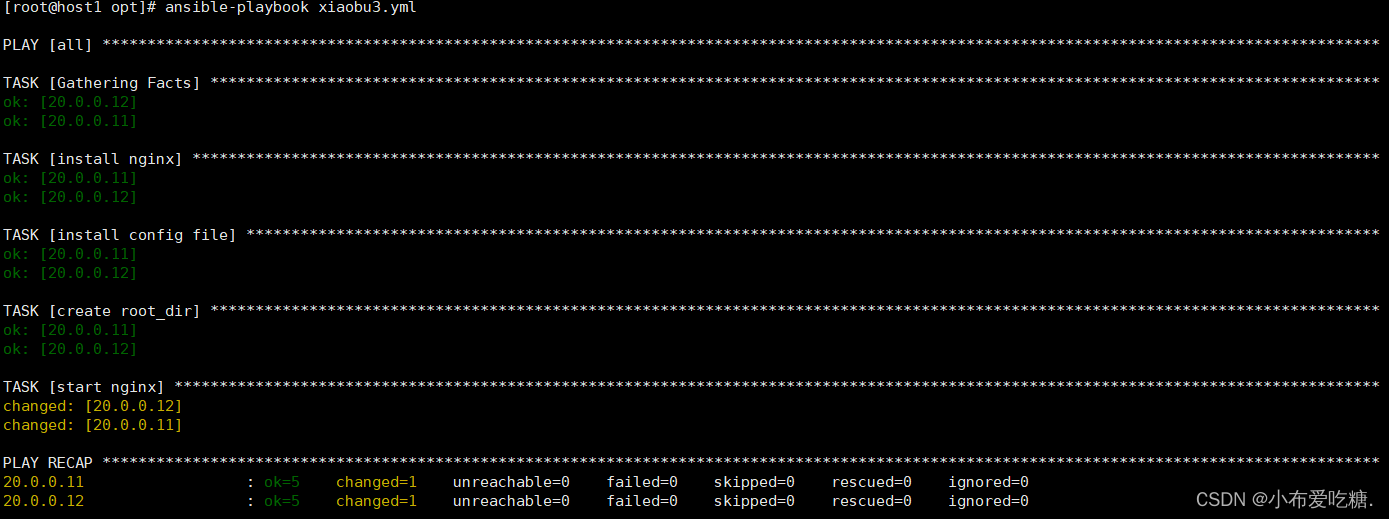
tags模块
标签模块,可以在playbook当中为任务设定标签(tags),我们在运行playbook是可以通过指定任务标签,来实现只运行设定的标任务
任务标签的种类
always 不管你是否指定了运行标签,任务都会执行
never 即使运行了指定标签,该任务也不会执行
debug 调试任务
任务标签
- hosts: allremote_user: rootgather_facts: falsetasks:- name: tag debugdebug:msg: "this is test1"tags:- debug- name: tag setupsetup:tags:- setup- name: tag alwaysdebug:msg: "run"tags:- always- name: tag neverdebug:msg: "never run"tags:- never
自定义标签
per_tasks 指定标签之前的任务
post_tasks 运行指定标签之后的任务
- hosts: allremote_user: rootgather_facts: falsetasks:- name: tag alwaysdebug:msg: "run"tags:- xiaobu- name: tag neverdebug:msg: "never run"tags:- xiaokai实验
1、在目标主机上touch xiaobu.txt always
2、在目标主机复制文件opt/xiaobu2.txt 标签never
实验目的
第一运行playbook 不指定标签查看文件生成情况
指定标签为never,查看文件生成情况
- hosts: allremote_user: rootgather_facts: falsetasks:- name: touch filefile:path: /opt/xiaobu.txtstate: touchtags:- always- name: copy filecopy:src: /opt/123dest: /opt/123tags:- neverRole模块
Role模块又叫角色
ansible层次化,结构化的组织playbook,使用了rolse(角色)
可以根据层次结构,自动装载变量文件,task,以及handler等等
Roles:分别把变量 文件 任务 模块以及处理器,放在单独的目录当中,使用roles模块来一键调用这些文件
roles结构
--- web---总目录,角色
files 存放copy和script模块调用的文件
Templates 存放j2的模块文件
tasks 包含任务的目录 ---- mail.yml 角色运行的任务
handlers 包含处理器的目录 ---- main.yml
vars 存放变量的目录 ----main.yml
defaults 包含默认变量的目录 -----main.yml
meta 包含元信息的目录----main.yml
在总目录下site.yml,用来调用所有配置文件
实验
三个服务
http mysql php
#安排剧本
cd /etc/ansible/roles/
mkdir httpd mysql php
cd httpd
mkdir files templates tasks handlers vars defaults meta
touch {defaults,vars,tasks,meta,handlers}/main.yml
cd mysql
mkdir files templates tasks handlers vars defaults meta
touch {defaults,vars,tasks,meta,handlers}/main.yml
cd php
mkdir files templates tasks handlers vars defaults meta
touch {defaults,vars,tasks,meta,handlers}/main.yml配置httpd
vim tasks/main.yml
- name: install httpdyum: name={{pkg}}
- name: start httpdservice: enabled=true name={{svc}} state=startedvim httpd/vars/main.yml
pkg: httpd
svc: httpd配置mysql
vim mysql/tasks/main.yml
- name: isntall mysqlyum: name={{pkg}}
- name: start mysqlservice: enabled=true name={{svc}} state=startedvim mysql/vars/main.yml
pkg:- mariadb- mariadb-server
svc: mariadb配置php
vim php/tasks/main.yml
- name: install phpyum: name={{pkg}}
- name: start phpservice: enabled=true name={{svc}} state=startedvim php/vars/main.yml
pkg: - php- php-fpm
svc: php-fpm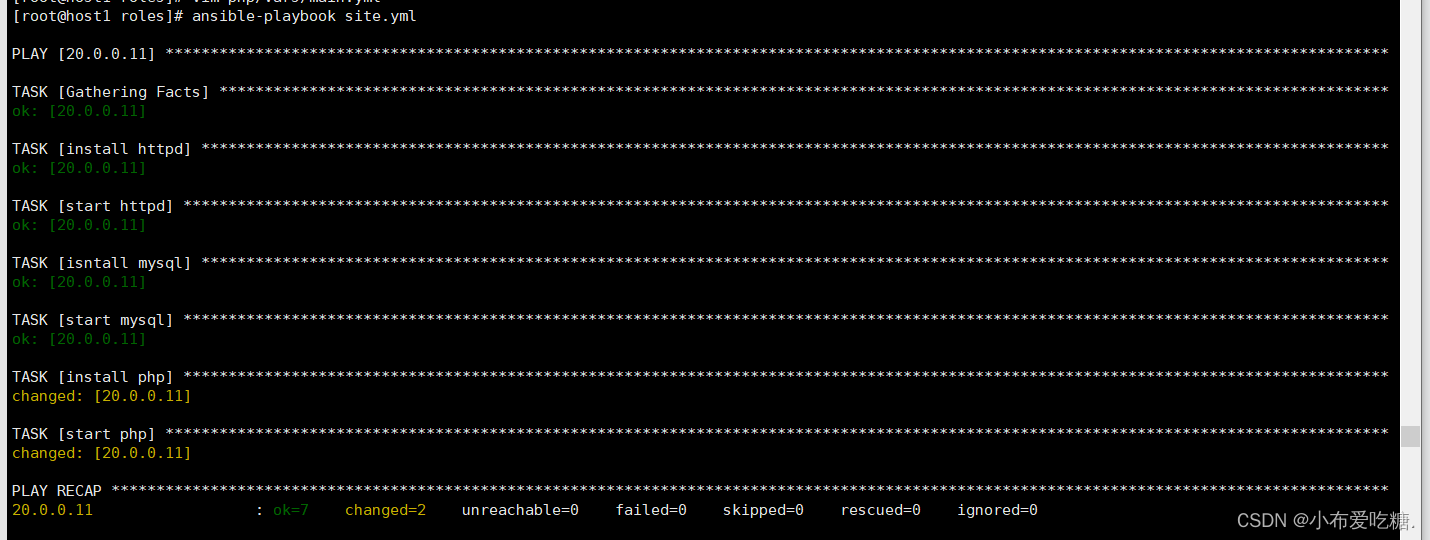


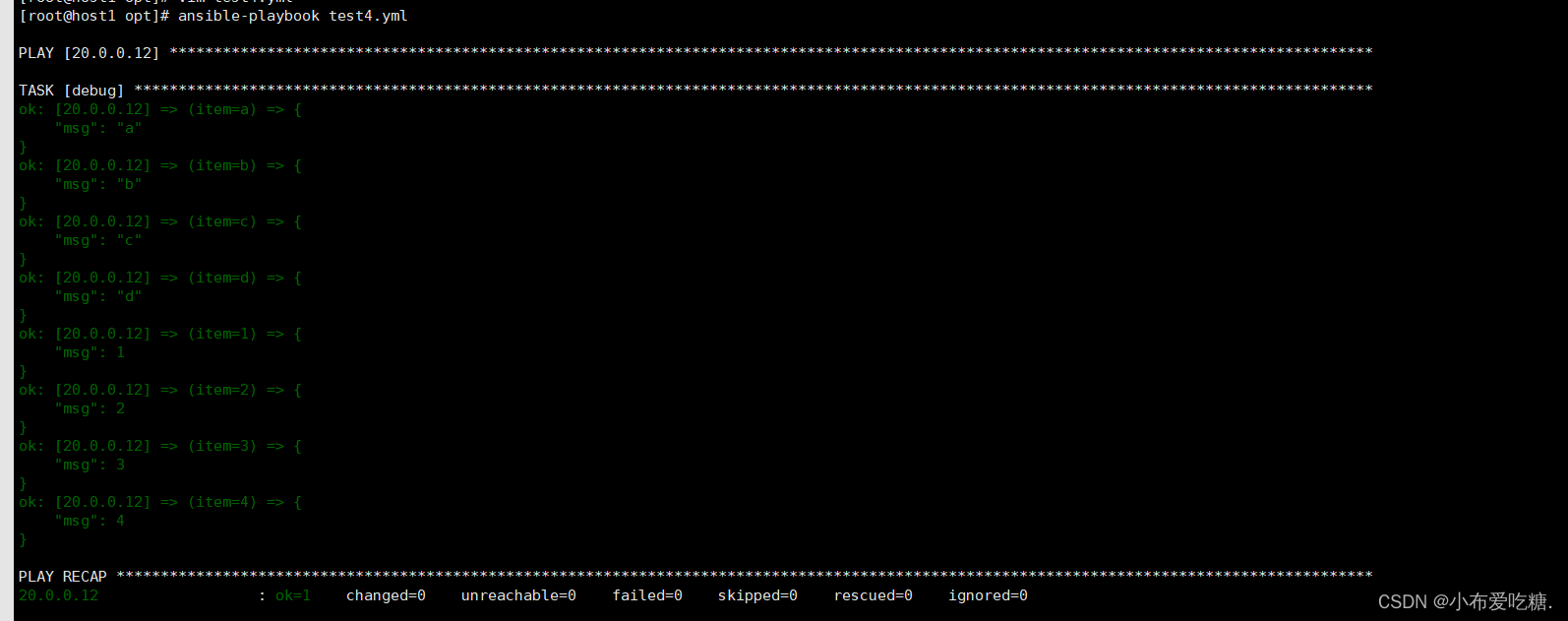






)





)
)


 求解并行机器调度的程序)




